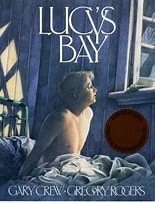Sam had stayed at his grandfather’s beach house for many summers. He loved the days here, but at night he was afraid, the night sounds came moaning and calling Sam to the shore of the tiny bay. Most days Sam went out exploring the beach, but never beyond the red cliffs, never to the next tiny bay, but at night came the fear and the memories. He told himself he was too big to be scared but his mouth was dry with fear and his eyes stared at the window till one night he sat up and said out loud, ‘Tomorrow I will go’. Along the beach, past the red cliffs around to the next bay, to the place where the sea had taken Lucy, Sam’s sister.
Burdened with grief and guilt, Sam has avoided the small beach where Lucy disappeared, as it had happened when he was supposed to be watching her. Now, at last he has found the courage to confront his past.
The text and the illustrations give a sense of foreboding, almost of menace. Words like ‘moaned’, ‘cried’ and ‘whispered’ create tension and show Sam’s fear. This tension is replicated in the muted colours used. The sky is cloudy, suggestive of rain and perhaps tears and the red cliffs, described as ‘great rocks reared from the sea’, are dark and overpowering, casting sinister shadows.
The tiny beach is ‘pure white sand swept down to the sea’ just as Lucy was, tiny, pure and swept into the sea. The image of Sam climbing down into the tiny bay is lighter in colour and there is relief in his whispered words, ‘I am here. At last’. He digs and finds the small memorial stone engraved with Lucy’s name. Caught on the stone is a tuft of gossamer and then, framed by clear blue sky, Sam blows the seeds into the wind releasing the seeds and himself. The final image is of Sam walking away in an open landscape and pondering what lay beyond Lucy’s Bay.
The text is spare and emotive and reflects the evocative artwork rendered in coloured pencil, coloured charcoal pencil, graphite, pastel, watercolour and acrylic paints against a textured sand coloured background. Throughout there are images both of entrapment and freedom, none more telling than the two images of the hermit crabs at the start and end of the book, the first closed and the second showing the crab emerged from its shell. ‘Lucy’s Bay’ is a powerful yet gentle view of complex emotions and a coming to terms with grief and guilt.

